QuestionQUESTION: Hello there :D
My Rabbit has an infected hand (ringworm) as diagnosed by our local vet. The problem is it looks like its really hurting her and she keeps licking it. She has been given a spray to treat the infection but I was wondering if there was anything else I could do to ease her pain in the meantime. She also recently cut her hand running in the garden because it is swollen, is there any way I can disinfect the wound?
ANSWER: Dear David,
Ringworm is not usually painful, and it's not really very common in rabbits. What does the affected area look like? And if it is no more than a swollen toe where she was cut, then I would worry about a bacterial infection. What is the name of the medication that you are using on the "ringworm" on the foot?
If the vet you saw was not an exotics vet well versed in rabbit medicine, then I would try to find a more experienced rabbit vet here:
www.rabbit.org/vets
for a second opinion.
I hope this helps.
Dana
---------- FOLLOW-UP ----------
QUESTION: Hi Dana thanks for your quick response.
I'll give you the full story..
We actually have 2 dwarf lop eared rabbits called Miffy and Pepo. At first the two rabbits lived together, but as Miffy got older she began to mount Pepo (who is younger by about 6 months) repeatedley so we had to seperate them.
A week later we noticed that Pepo had started sneezing and had a discharge coming out of her nose. We took her to a local vet (an exotics vet who apparently is a rabbit specialist, but is strangley allergic to rabbits). He diagnosed her with Paesturella and treated her with Penecillin injections for 1 week. He said this was neccersary because Rabbits don't usually get through pasturella and he had had success in the past using these injections.
A few weeks later Pepo began to lose hair on her feet, hands and face.. Her hands were very swollen and red. We took her back to the vets and he told us she has a fungal infection (Ringworm) which he diagnosed by shining a UV light on her skin. He gave us a spray called Mycozole
http://www.noahcompendium.co.uk/Genitrix_Ltd/Mycozole/-44574.html
to treat the condition, and it appears to have gotten a little better, but her hair has not grown back around the eyes.
Here is a picture of Pepo at the moment..
http://java.cms.livjm.ac.uk/homepage/staff/taedfolk/Pepo_ringworm.jpg
Now Miffy (the older rabbit), has started to exhibit similar symptoms on her feet.. And that was what my original question was pertaining to. heres the foot..
http://java.cms.livjm.ac.uk/homepage/staff/taedfolk/miffysfoot.jpg
Shes in quite a bit of pain with it and I was just wondering if there was anything else I could do to ease my bunnies suffering.
Thanks again for all your help
Dave
ANSWER: Dear Dave,
Have you been washing any type of crust off of Pepo's face? I ask because the location of the hair loss is *very* typical of a rabbit with mange, caused by parasitic mites. You can see pictures of rabbits with *advanced* mange and ear mites here:
www.bio.miami.edu/hare/furloss.html
but the condition starts out with very slight flaking/crustiness on the skin, and then gradually progresses. The condition almost always starts to show up first on the nose, around the eyes, and on the toes. And it looks a LOT like Pepo in the picture you posted.
Rabbits usually harbor small populations of mites all the time, but show clinical signs only when stressed. It is possible that the upper respiratory infection was enough to trigger the mange outbreak (if that's what this is). In some cases, fungal co-pathogens take up residence in the areas where mange has taken hold, which could explain why the vet saw signs of fungus upon UV examination of the area.
I would ask about trying Revolution (selamectin) on the bunnies. It is extremely effective against mites, and we have never had any problems with it. The affected areas will start to re-grow hair in about a week or ten days after application of Revolution, if I'm correct and this is mange.
In my opinion, it wouldn't hurt to ask about it and give it a try. I am betting it will work.
When the vet proclaimed that your rabbit had Pasteurella, did he confirm this with a culture and sensitivity test? Please read:
www.bio.miami.edu/hare/culture.html
If no c & s was done, then the Pasteurella diagnosis is a guess, at best. And it is possible that the bacteria causing the sneezing are (1) not Pasteurella and (2) not sensitive to penicillin. Please also read:
www.bio.miami.edu/hare/sneezing.html
It is also not true that "most rabbits don't make it through Pasteurella." I'm not sure why any truly rabbit-experienced vet would say that. Pasteurella is not uncommon in rabits, it can manifest in different ways (upper respiratory infection, abscesses, etc.), and it is eminently treatable, even if one can never completely eradicate the entire population of bacteria. We've had rabbits test positive for Pasteurella who lived into their teens.
This makes me wonder if it might not be wise to seek another rabbit-savvy vet for a second opinion:
www.rabbit.org/vets
Miffy's feet look as if they are suffering from contact irritation, and I notice that her claws are a bit long, at least in the picture. When a bunny's claws are too long, pressure on them (from walking on a hard surface) can overextend the toes, causing the fur to wear abnormally and cause bald spots on the toe pads. Trimming the nails back to just about a millimeter beyond the quick will help resolve this problem. Treating with Revolution will eliminate any contribution to this problem being made by the mites. Be sure the surface she's on is padded and soft (not slick, which will make things worse), so abrasion won't exacerbate the fur loss.
If your bunnies are showing signs of pain, then please ask the (new?) vet about getting some pain medication, which is really important for a rabbit. We have used metacam (an NSAID) in combination with tramadol (a synthetic opioid) with excellent results. Just making the bunny feel better can go a long way to helping with a full recovery.
If your girls are not spayed, this is also very important, as unspayed, unbred female rabbits have a very high risk of uterine adenocarcinoma (cancer). It will also help stop the mounting behavior, and may allow you to re-introduce the two bunnies (carefully! use the tips found here: http://search.atomz.com/search/?sp-a=00062824-sp00000000&sp-q=
bonding&user=enter+email+address ) so they can be a bonded pair again.
I hope this helps get you started on the road to their full recovery. Good luck, and please write back if you have more questions.
Dana
---------- FOLLOW-UP ----------
QUESTION: Hi Dana,
Is this the treatment you mean?
http://www.revolution4dogs.com/content.asp?country=US?=EN&drug=RV&species=CN&sec
I can only find it for dogs and cats. Is it the same thing?
I was very worried about getting our rabbits spayed because the vet was saying that there can be a chance that our rabbits would die under anestetic. Is it a common operation?
We try putting new sawdust in miffys hutch but she just moves it out the way to make a hole that she sits in the hutch. We replace it every day but she just moves the new sawdust into the corner and makes a big pile, while exposing the wooden floor of the hutch. Maybe we could put litle pillows in there?
Thanks for all your help
Dave
AnswerDear David,
Yes, Revolution for dogs and cats is the same thing we use on rabbits. All the different sized tubes contain the same concentration of the solution, so it doesn't matter what size you buy. We use about 6-8 drops on the back of the neck, and it lasts for about a month.
As far as the risk of spaying is concerned, it's true that no surgery or anesthesia is 100% risk free. But since unspayed, unbred female rabbits have a very high incidence of uterine cancer, most of us feel that the small risk (when the surgery is done by a confident, experienced, adept surgeon who knows the proper way to anesthetize a rabbit) is worth the lifelong protection.
The operation is very common these days. If your present vet has a low success rate for this surgery, or seems to be trying to dissuade you (perhaps because he doesn't feel as confident with surgery on rabbits as on dogs and cats?), then I would definitely use the list linked here:
www.rabbit.org/vets
to find another vet for a second opinion. ALL our female rabbits are spayed, and we have never lost anyone to that surgery. I won't say rabbits *never* die under anesthesia. Some do. So do dogs, cats, and humans. But this is a relatively rare thing if the veterinarian is experienced, and the bunnies undergo a good wellness check in advance (including bloodwork, if you want to be very thorough) to be sure there are no underlying health problems that might increase the risk of problems under anesthesia.
Miffy's making a little hole to sleep on isn't uncommon. Many rabbits like a smooth, cool surface. I think just keeping her nails shorter will help for starters. But if the toes continue to be red and swollen, she may need to wear little fur-padded mittens for a while, as explained here:
www.bio.miami.edu/hare/sorehocks.html
I hope that helps!
Dana

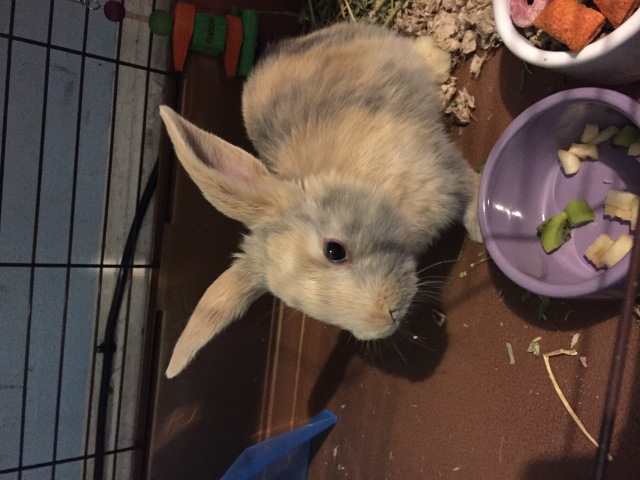 Bunny breed
Question
Breed Breed
Hi, I just rescued a
Bunny breed
Question
Breed Breed
Hi, I just rescued a
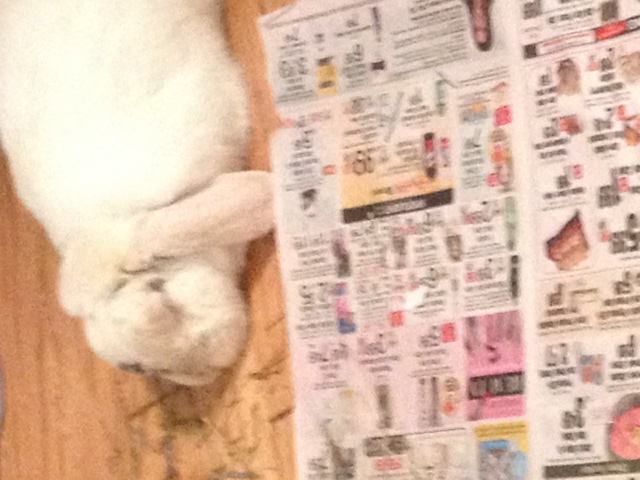 GI stasis
Question
So relaxed
Hi, I wanted to let you know
GI stasis
Question
So relaxed
Hi, I wanted to let you know
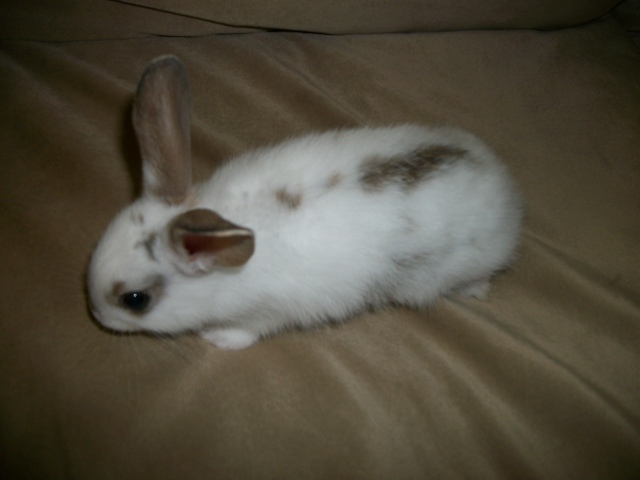 Is my bunnie to young
Question
Koby, My Bunny
I just got a bunny yesterday, a
Is my bunnie to young
Question
Koby, My Bunny
I just got a bunny yesterday, a
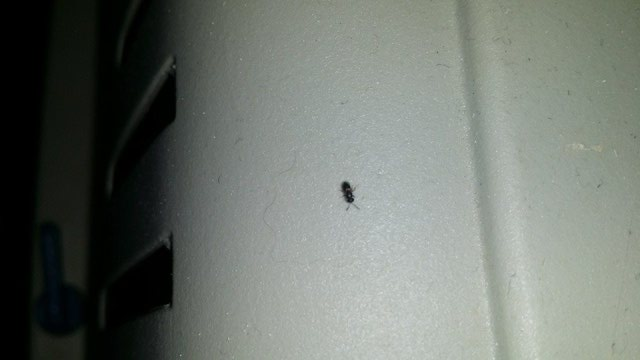 insects and rabbits
Question
bug1 bug2
Hello I have found thes
insects and rabbits
Question
bug1 bug2
Hello I have found thes
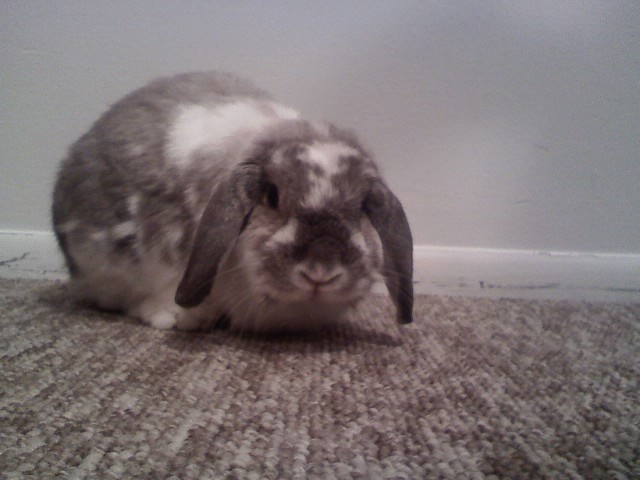 Poop butt
QuestionFoo bunny
QUESTION: I have a 4 yr old ne
Poop butt
QuestionFoo bunny
QUESTION: I have a 4 yr old ne